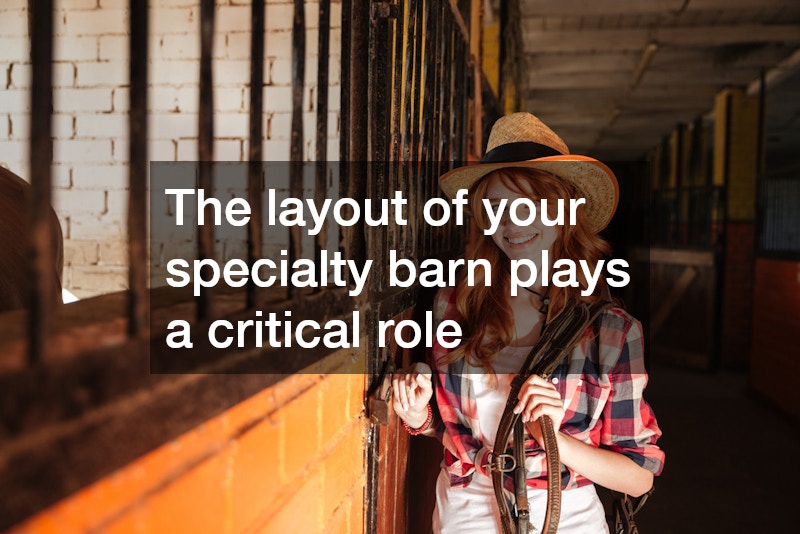There are many innovative design ideas to consider during the specialty barn construction process. As these buildings often serve specific purposes, a tailored approach to design is essential for functionality, aesthetics, and durability.
Essential Features
When planning for a specialty barn, you must focus on the specific needs that the barn will accommodate. Features such as proper ventilation, ample lighting, and accessible storage are essential for creating a comfortable and efficient environment.
Additionally, including designated areas for equipment and animal care can further streamline operations.
Another vital aspect to consider is the adaptability of the barn. Depending on your future plans, having partitions or movable structures can allow you to adjust the space as needs change over time. This flexibility ensures longevity and continued use without extensive renovations.
Lastly, integrating technology into your barn design can enhance its operational efficiency. Automated feeding systems, climate control, and smart management systems can help optimize conditions within the barn, reducing the need for hands-on management while also supporting best practices in animal husbandry.
Optimized Layout
The layout of your specialty barn plays a critical role in how functional and efficient it will be. A well-thought-out layout not only maximizes space but also ensures that areas essential for operations are close to one another. For instance, placing feed storage near feeding areas can greatly reduce the time spent moving between tasks.
Creating clear pathways is also important. Ensure that there are dedicated routes for people and equipment to navigate through the barn. This minimizes the risk of accidents and helps maintain a smooth workflow, especially during busy times. Open spaces can be particularly useful for large machinery or for handling livestock.
Moreover, consider the flow of operations from start to finish and design the layout accordingly. Think about the sequence of activities that will take place within the barn, such as feeding, cleaning, or maintenance. Arranging these functions in a logical order can improve productivity and reduce unnecessary movement, enhancing overall efficiency.
Construction Materials
Choosing the right materials for your specialty barn construction is paramount. Traditional materials like wood and metal each have distinct advantages and challenges. For instance, wood can provide excellent insulation and aesthetic appeal, but it may require more maintenance over time to protect against pests and decay.
Metal buildings, on the other hand, are known for their durability and resistance to environmental factors. They often require less upkeep and offer a long lifespan. However, they may necessitate additional insulation to ensure climate control inside the barn, which is critical for animal comfort and preservation of feed and supplies.
Additionally, integrating recycled or sustainable materials can contribute positively to environmental conservation. Materials such as reclaimed wood or insulated concrete forms can enhance the efficiency and sustainability of the barn while reducing the overall carbon footprint. Carefully evaluating these options can lead to a strong, effective building that stands the test of time.
Sustainable Practices
Integrating sustainable practices into your specialty barn design begins with evaluating environmental impact. By using renewable resources and energy-efficient technologies, you can create a building that minimizes its ecological footprint. This could include solar panels, rainwater harvesting systems, and energy-saving insulation to reduce energy consumption.
Design choices that enhance natural light can significantly impact energy usage, reducing the need for artificial lighting. Strategic placement of windows and skylights can provide ample sunlight during the day, benefiting both animals and workers. Moreover, thoughtful ventilation systems can enhance air quality and reduce the need for mechanical systems.
Promoting biodiversity through landscape design around the barn can also contribute to sustainability. Integrating native plants and creating habitats for beneficial wildlife can enhance the surrounding ecosystem while decreasing maintenance time and resources. This holistic approach to barn design reflects a commitment to sustainable practices in agriculture.
Specialty Aesthetics
Aesthetics in specialty barn design can play a significant role in overall satisfaction and functionality. The visual appeal can enhance not only the experience for those working in or visiting the barn but can also contribute to property value. Choosing a cohesive color palette that reflects the surrounding environment can create a pleasing appearance that complements the natural landscape.
Architectural details such as gables, cupolas, and porches can add character and charm to the barn, creating an inviting atmosphere. Texture variations between materials can also enhance visual interest while tying in with the barn’s use and purpose. For specialty barns, aesthetics should not overshadow functionality but should harmoniously coexist.
Lastly, paying attention to landscape design around the barn can significantly impact its overall appearance. Incorporating pathways, gardens, or fencing can create a beautiful context for the structure itself while ensuring that the space remains practical for its intended use. The integration of beauty and utility should guide every design decision, creating a truly special barn.
Designing a specialty barn entails careful consideration of various factors, from layout to materials to aesthetics. By integrating thoughtful design elements and sustainable practices, you can create a barn that is both functional and beautiful.

